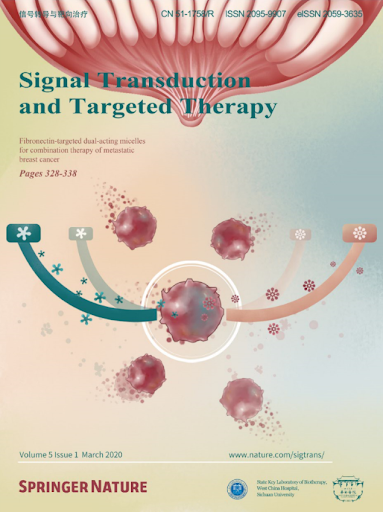TRIM28介导的DDX39B k63连锁泛素化通过增强ECAD溶酶体降解促进NSCLC转移。
IF 40.8
1区 医学
Q1 BIOCHEMISTRY & MOLECULAR BIOLOGY
引用次数: 0
摘要
转移是非小细胞肺癌(NSCLC)治疗失败和高死亡率的主要原因。最近,我们发现DEAD盒解旋酶39B (DDX39B)在结直肠癌和肝细胞癌中上调并激活代谢重编程。然而,DDX39B在NSCLC中的功能和靶向DDX39B的治疗潜力尚不清楚。在此,我们发现DDX39B是NSCLC患者生存不良的独立标志物。引人注目的是,DDX39B蛋白在临床转移性脑病变和转移细胞模型(体外emt转移和体内颈动脉注射诱导的脑转移细胞模型)中升高,而不是其mRNA升高。机制上,DDX39B通过Pro322残基与E3泛素连接酶TRIM28相互作用,并在Lys241、Lys384和Lys398位点进行TRIM28介导的k63连接泛素化,导致DDX39B蛋白稳定和上调。随后,DDX39B直接与ECAD结合,通过募集Src和Hakai促进ECAD溶酶体降解,而这一过程不依赖于其RNA解旋酶活性,进而激活β-catenin致癌信号,促进NSCLC侵袭性表型。通过基于结构的虚拟筛选,我们发现一种临床抗疟药物青蒿琥酯可以破坏DDX39B- trim28复合物的关联,导致DDX39B降解并阻断DDX39B的促转移作用。总之,我们的研究结果表明TRIM28/DDX39B/ECAD轴有助于NSCLC转移,并且通过青蒿琥酯靶向DDX39B降解是治疗NSCLC的有效且有前景的治疗方法。本文章由计算机程序翻译,如有差异,请以英文原文为准。
DDX39B K63-linked ubiquitination mediated by TRIM28 promotes NSCLC metastasis by enhancing ECAD lysosomal degradation.
Metastasis is a leading cause of treatment failure and high mortality in non-small cell lung cancer (NSCLC). Recently, we demonstrated that DEAD box helicase 39B (DDX39B) was upregulated and activated metabolic reprogramming in colorectal cancer and hepatocellular carcinoma. However, the function of DDX39B and the therapeutic potential for targeting DDX39B in NSCLC remain unclear. Herein, we discovered that DDX39B was an independent marker for poor survival in NSCLC patients. Strikingly, DDX39B protein, but not its mRNA, was elevated in clinical metastatic brain lesions and metastatic cell models (in vitro EMT-metastatic and in vivo carotid artery injection-induced brain-metastatic cell model). Mechanistically, DDX39B interacted with E3 ubiquitin ligase TRIM28 via Pro322 residue and underwent TRIM28-mediated K63-linked ubiquitination at Lys241, Lys384, and Lys398, leading to DDX39B protein stabilization and upregulation. Subsequently, DDX39B directly bound to ECAD and promoted ECAD lysosomal degradation by recruiting Src and Hakai, which was independent of its RNA helicase activity, followed by activating β-catenin oncogenic signaling and facilitating NSCLC aggressive phenotype. According to structure-based virtual screening, we discovered a clinical antimalarial drug, artesunate, that disrupted the association of DDX39B-TRIM28 complex, resulting in DDX39B degradation and blocking the pro-metastatic effects of DDX39B. Overall, our findings uncover that TRIM28/DDX39B/ECAD axis contributes to NSCLC metastasis and targeting DDX39B degradation by artesunate is an effective and promising therapeutic approach for the treatment of NSCLC.
求助全文
通过发布文献求助,成功后即可免费获取论文全文。
去求助
来源期刊

Signal Transduction and Targeted Therapy
Biochemistry, Genetics and Molecular Biology-Genetics
CiteScore
44.50
自引率
1.50%
发文量
384
审稿时长
5 weeks
期刊介绍:
Signal Transduction and Targeted Therapy is an open access journal that focuses on timely publication of cutting-edge discoveries and advancements in basic science and clinical research related to signal transduction and targeted therapy.
Scope: The journal covers research on major human diseases, including, but not limited to:
Cancer,Cardiovascular diseases,Autoimmune diseases,Nervous system diseases.
 求助内容:
求助内容: 应助结果提醒方式:
应助结果提醒方式:


